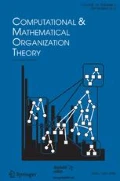Abstract
Organizations that operate in a dynamic environment must take steps to adapt to their changing circumstances; otherwise, they may collapse entirely. Yet, managers may postpone necessary change to minimize costs, while ignoring the risk that this myopic approach entails to the survival of their organizations. This paper proposes a model that considers failure as a stage-wise process of decline, in which the organization’s portfolio of products and the technological processes that it uses to produce them become increasingly misaligned with market conditions. Eventually, if management fails to adapt to the market in time, the gap between the organization and its environment expands to a point of no return, after which organizational collapse is inevitable. The model enables us to run computerized simulations to predict the lifespan of organizations.





Similar content being viewed by others
References
Agarwal R (1996) Technological activity and survival of firms. Econ Lett 52:101–108
Ansoff HI, McDonnell EJ (1990) Implanting strategic management. Prentice Hall, UK
Barr PS, Stimpert JL, Huff AS (1992) Cognitive change, strategic action, and organizational renewal. Strateg Manag J 13:15–36
Bernard AB, Redding SJ, Schott PK (2010) Multiple-product firms and product switching. Am Econ Rev 100:70–97
Boynton AC, Victor B (1991) Beyond flexibility: building and managing the dynamically stable organization. Calif Manag Rev 34:53–66
Cefis E, Marsili O (2006) Survivor: the role of innovation in firms’ survival. Res Policy 35:626–641
Chao RO, Kavadias S (2008) A theoretical framework for managing the new product development portfolio: when and how to use strategic buckets. Manag Sci 54(5):907–921
Comin D, Hobijn B, Rovito E (2006) Five facts you need to know about technology diffusion. NBER Working Papers No. 11928
Foster R, Kaplan S (2001) Creative destruction: why companies that are built to last underperform the market—and how to successfully transform them. Currency, New York
Goldberg PK, Khandelwal AK, Pavcnik N, Topalova P (2010) Multiproduct firms and product turnover in the developing world: evidence from India. Rev Econ Stat 92:1042–1049
Greenhalgh L (1983) Organizational decline. In: Bacharach SB (ed) Research in the sociology of organizations, vol 2. JAI Press, Greenwich, pp 231–276
Greiner LE (1992) Resistance to change during restructuring. J Manag Inq 1:61–65
Hannan MT, Freeman J (1984) Structural inertia and organizational change. Am Sociol Rev 49:149–164
Harrison R (1970) Choosing the depth of organizational intervention. J Appl Behav Sci 6:182–202
Janis IL (1982) Groupthink: psychological studies of policy decisions and fiascoes. Houghton Mifflin, Boston
Johns EA (1973) The sociology of organizational change. Pergamon Press, Oxford
Kahneman D, Lovallo D (1993) Timid choices and bold forecasts: a cognitive perspective on risk taking. Manag Sci 39(1):17–31
Krishnan V, Ulrich KT (2001) Product development decisions: a review of the literature. Manag Sci 47(1):1–21
Lorscheid I, Heine BO, Meyer M (2012) Opening the ‘black box’ of simulations: increased transparency and effective communication through the systematic design of experiments. Comput Math Organ Theory 18(1):22–62
McKinley W, Latham S, Braun M (2014) Organizational decline and innovation: turnarounds and downward spirals. Acad Manag Rev 39(1):88–110
Milkau U (2013) Adequate communication about operational risk in the business line. J Oper Risk 8(1):35–57
Navarro L (2012) Plant level evidence on product mix changes in Chilean manufacturing. J Int Trade Econ Dev 21(2):165–195
Pavlou PA, El Sawy OA (2011) Understanding the elusive black box of dynamic capabilities. Decis Sci 42(1):239–273
Pich MT, Loch C, De Meyer A (2002) On uncertainty, ambiguity, and complexity in project management. Manag Sci 48(8):1008–1023
Raz T, Shenhar AJ, Dvir D (2002) Risk management, project success, and technological uncertainty. R&D Manag 32(2):101–109
Richard PJ, Devinney TM, Yip GS, Johnson G (2009) Measuring organizational performance: towards methodological best practice. J Manag 35(3):718–804
Samuel Y, Jacobsen C (1997) A system dynamics model of planned organizational change. Comput Math Organ Theory 3(3):151–171
Siggelkow N (2002) Misperceiving interactions among complements and substitutes: organizational consequences. Manag Sci 48(7):900–916
Simon HA (1957) Models of man social and rational. Wiley, New York
Simon HA (1972) Theories of bounded rationality. In: McGuire CB, Radner R (eds) Decision and organization. North-Holland, Amsterdam, pp 161–176
Sinha RK, Noble CH (2008) The adoption of radical manufacturing technologies and firm survival. Strateg Manag J 29(9):943–962
Staw BM, Sandelands LE, Dutton JE (1981) Threat-rigidity effects in organizational behavior: a multilevel analysis. Adm Sci Q 26:501–524
Sutton RI (2005) Organizational decline and death. In: Nicholson N (ed) Blackwell encyclopedic dictionary of organizational behavior. Blackwell, Cambridge, pp 382–383
Tewari I, Wilde J (2013) Product mix and misallocation: evidence from India’s product dereservation policy. Mimeo
Thomas JB, Clark SM, Gioia DA (1993) Strategic sensemaking and organizational performance: linkages among scanning, interpretation, action, and outcomes. Acad Manag J 36(2):239–270
Trahms CA, Ndofor HA, Sirmon DG (2013) Organizational decline and turnaround: a review and agenda for future research. J Manag 39(5):1277–1307
Tushman ML, Romanelli E (1985) Organizational evolution: a metamorphosis model of convergence and reorientation. In: Cummings LL, Staw BM (eds) Research in organizational behavior, vol 7. JAI Press, Greenwich, pp 171–222
Tversky A, Kahneman D (1992) Advances in prospect theory: cumulative representation of uncertainty. J Risk Uncertain 5(4):297–323
Venkatesh V, Davis FD (2000) A theoretical extension of the technology acceptance model: four longitudinal field studies. Manag Sci 46(2):186–204
Weitzel W, Jonsson E (1989) Decline in organizations: a literature integration and extension. Adm Sci Q 34:91–109
Winter SG (2003) Understanding dynamic capabilities. Strateg Manag J 24(10):991–995
Author information
Authors and Affiliations
Corresponding author
Rights and permissions
About this article
Cite this article
Winer, Z., Samuel, Y. The paradox of cost minimization and the survival of organizations. Comput Math Organ Theory 24, 401–421 (2018). https://doi.org/10.1007/s10588-017-9261-5
Published:
Issue Date:
DOI: https://doi.org/10.1007/s10588-017-9261-5




